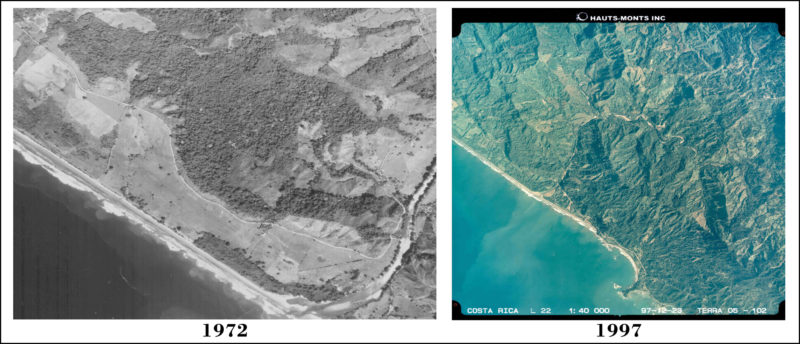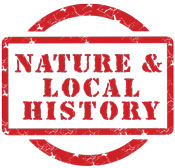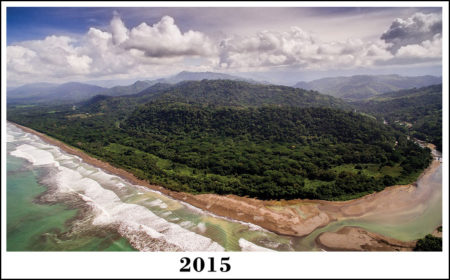Sins of the Past

 By Jack Ewing
By Jack Ewing
Today the Pacific coastal region of Costa Rica south of the Savegre River is covered with forests, wetlands, mangroves, and other natural wonders. Biodiversity is increasing in much of the area, especially the Path of the Tapir Biological Corridor (PTBC). National parks, wildlife refuges, and private reserves abound, as do other attractions of interest to ecological tourism. It has been called “The Land of Big Parks and Small Hotels”. But it hasn’t always been that way. Beginning in the 1940s a major deforestation of the area took place. Trees were felled and burned, land was cleared, and crops and cattle pasture were planted. The destruction continued for four and a half decades, until about 1985, which marked the beginning of a period of restoration that has persisted to the present day, and hopefully will continue for many years to come.
You may ask, “Why would the government allow such devastation of the rainforest”? The truth is that the government encouraged the deforestation. I came to this region in the early 1970s, 12 years prior to the peak of the clearing of land. In those days the forestry department was part of the Ministry of Agriculture, and the Ministry of the Environment didn’t exist. What little tourism that came to Costa Rica was centered around night clubs and museums in San Jose, with an occasional trip to a volcano. The national income from foreign visitors was insignificant. The mainstays of the economy were beef, bananas, and coffee, and you can’t grow beef, bananas, and coffee in a rainforest. So this fascinating habitat, which harbors more biomass and biodiversity than any other on the planet, was viewed as an unproductive wasteland. “Cut it down, and make the land produce”, was the message the government sent to any who were hardy and willing enough to brave the wild, tame Mother Nature, and work the land.
Today, in the course of my work at Hacienda Barú National Wildlife Refuge I often give lectures to groups of visitors. At the beginning of the talk I show photos of the rainforest and other tropical habitats, flora and fauna, Path of the Tapir Biological Corridor, and the Savegre Biosphere Reserve. I am always sure to mention that the area is one of the few places in the world where biodiversity is increasing. This will occasionally elicit a raised eyebrow and perhaps a question or comment like, “It is a beautiful place and the flora and fauna are impressive, but how is it that the biodiversity in increasing? How do you know that this is true”? Then I show them an aerial photo of the area taken in 1972 that shows a land covered with pasture and rice fields, forest on the steepest slopes, mangroves bordered by pasture right up to the edge, and a few other small parcels of natural vegetation in the lowlands. More than half of the land is devoid of trees.
 “This is what we started with”, I say, “and this wasn’t the peak of the deforestation. That came about 12 years later”. This usually results in amazement, and more often than not, provokes a few gasps, expressions of disgust, and exclamations about how horrible, and what kind of people would do such a thing? At first I was surprised at the extreme disgust toward the people who carried out the deforestation. But I came to understand that the visitors, more than likely, thought that the destruction had been carried out by greedy multinational corporations, not by poor, humble, Costa Rican pioneers whose only tools were axes, machetes, and fire.
“This is what we started with”, I say, “and this wasn’t the peak of the deforestation. That came about 12 years later”. This usually results in amazement, and more often than not, provokes a few gasps, expressions of disgust, and exclamations about how horrible, and what kind of people would do such a thing? At first I was surprised at the extreme disgust toward the people who carried out the deforestation. But I came to understand that the visitors, more than likely, thought that the destruction had been carried out by greedy multinational corporations, not by poor, humble, Costa Rican pioneers whose only tools were axes, machetes, and fire.
I knew many of those campesinos who wielded the axes and machetes and lit the fires. They were my friends. Not many of those old timers are still with us today, but some lived long enough to see that destroying the rainforest and killing wildlife is not the only way to make a living. Their sons and daughters, as well as their grandchildren, now work in hotels and restaurants, drive taxis, and guide visitors on nature tours. They learned that there are people in the world who will pay good money to visit this region with the sole purpose of observing our natural treasures.
Some of their stories appear in my book Where Tapirs and Jaguars Once Roamed. Here’s what I said in those pages of the man who killed the last tapir in the region:
The dead tapir that Manuel Angel found on Barú Beach was not the last he would ever see. Two years later, in 1957, he shot and killed a tapir in the highland rainforest of Hacienda Barú. At the time he didn’t think anything about the possibility that he was killing the last one. Manuel was a hardworking, hard-drinking macho man, and he was also a hunter. He killed almost any wild animal he saw. To him the last one was no different than the first. Years later he grudgingly admitted that he probably should have let it live, but showed no signs of remorse.
Many other old time hunters have learned to appreciate the living animals, and express their regret at having killed them in the past. The way we make our living is all important in determining how we use the land. Cattle ranching requires destruction of the natural environment, and ecological tourism protects that environment. When Hacienda Barú was a cattle ranch we were using about 45% of the land, and the other 55% was in a natural state. We had only three full time employees, and only the foreman earned enough to own a bicycle. Today as an ecotourism destination we are using only 4% of the land, and have returned the rest to Mother Nature. We have 39 full time employees and have to make rules that they can’t park their cars and motorcycles in the best parking places, which are reserved for clients. Living conditions for local communities have improved tremendously. Many of the younger people have no knowledge of the farming and ranching days that their parents and grandparents lived through. It is important to remember and learn from the way our ancestors lived, and time to forgive the sins of the past.
Jack Ewing was born and educated in Colorado. In 1970 he and his wife Diane moved to the jungles of Costa Rica where they raised two children, Natalie and Chris. A newfound fascination with the rainforest was responsible for his transformation from cattle rancher into environmentalist and naturalist. His many years of living in the rainforest have rendered a multitude of personal experiences, many of which are recounted in his published collection of essays, Monkeys are Made of Chocolate. His latest book is, Where Jaguars & Tapirs Once Roamed: Ever-evolving Costa Rica. Jack and Diane live on and manage the Hacienda Barú National Wildlife Refuge, a well-known ecotourism destination on the southwest coast of Costa Rica.

